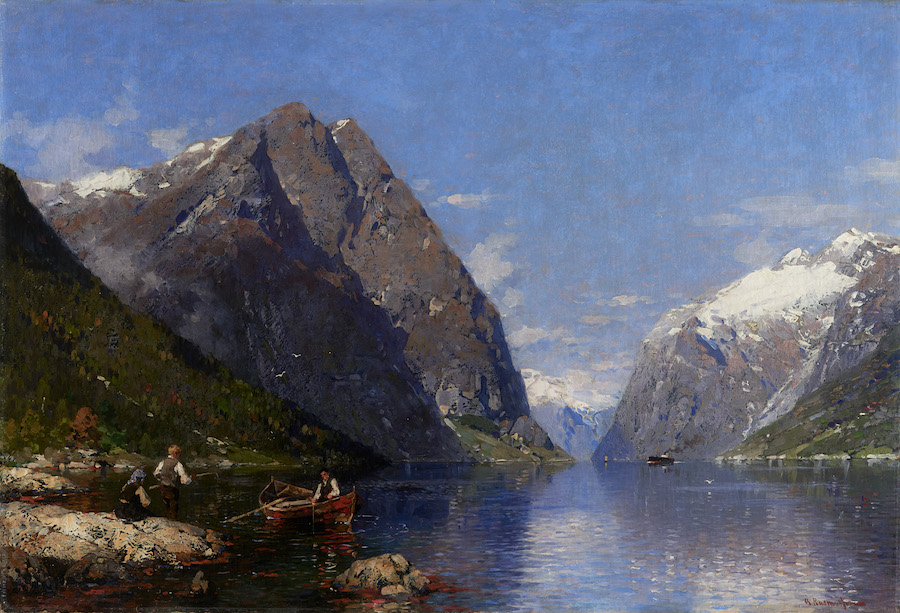Visitors to the Oceanographic Museum are invited to journey from Föhr in Northern Germany to the Netherlands, Denmark and Norway in an exciting new exhibition that reveals the beauty of the North Sea and the importance of preserving its coastal and marine areas.
The Museum Kunst der Westküste, located in Alkersum on the North Sea island of Föhr, Germany, is presenting the ‘Northbound. Connected by the Sea’ exhibition at the Oceanographic Museum of Monaco from 19th March to 19th June 2022. It brings together 24 paintings and photographs, historical and contemporary works which illustrate the role of the North Sea and the importance of preserving its coastal and marine areas. The Northbound exhibition, scheduled as part of Monaco Ocean Week, will be complemented by a scientific symposium entitled ‘The North Sea, a Sea of Solutions’, on 11th May 2022.
The North Sea, a shelf sea in Northwestern Europe, is revealed through an exclusive selection of paintings and photographs from the collection of the Museum Kunst der Westküste, providing exhibition visitors with a visual voyage across four ports of call.
First stop is the Netherlands, where artworks such as Cool Early Spring on Scheveningen Pier by Isaac Israëls (1865–1934) is characterised by a warm grey-blue tone. The tour then heads to Denmark where the Skagen Painters, a group of Scandinavian artists who gathered in the village of Skagen in the northernmost part of Denmark, captured in their compositions the famous ‘blue hour’ specific to Danish outdoor painting since the 1880s. These atmospheric conditions are characteristic of Peder Severin Krøyers (1851-1909) renderings of Skagens beaches, such as Fishermen on the Beach at Skagen, Mild Summer Evening or Anna Ancher and Marie Krøyer on the Beach at Skagen – a work loaned by the Broere Charitable Foundation, a patron of the Oceanographic Institute.

Contemporary artists are perpetuating this tradition by capturing in their photographs the twilight of ‘blue hour’, as seen in Skagen VI (2008) by Joakim Eskildsen.
In Norway, landscapes are romantic and emotive in conception, as seen in A Norwegian Fjord in Summer by Georg Anton Rasmussen (1842-1914).
Finally, the journey highlights the wonderful island of Föhr in North Frisia (Germany), with its special cultural and scenic features. The seascape of Otto H. Engel (1866-1949) makes Frisian culture around 1900 very vivid, whether through pictorial figures as in Evening Beach Scene, the interior of Frisian houses as in Frisian Parlour, or portrait painting as in In Front of the Mirror, which shows a woman from Föhr wearing traditional costume and readjusting her embroidered headscarf.
All the works presented have a common denominator: the sea. For centuries artists have challenged themselves to ‘capture’ this subject, which never stands still. In constant motion, the sea changes continually in its overall appearance, its colours, its temperament. At times the sea captivates by its calm, smooth, reflective surface. At times it is immersed in green, blue or sometimes grey, interspersed with white crests formed by the waves.

By creating a dialogue between historical and contemporary artworks, the Northbound exhibition is inviting visitors to explore the role played by the North Sea throughout history. The exhibition also highlights the role the North Sea played and continues to play in the cultural links between the island of Föhr, Northern Germany, Denmark, the Netherlands and Norway. These regions are also linked by the threat posed by climate change, pollution and overfishing. By letting visitors appreciate the beauties and characteristics of the North Sea region, the aim is to draw their attention to the importance of protecting coasts and encourage as many people as possible to have a responsible attitude towards nature.
Guided tours of the exhibition will be offered during school holidays as well as a treasure hunt, accessible online, for schoolchildren and their parents.
The exhibition will be complemented by a scientific symposium open to the public. It will address, using a comparative approach, the challenges to be met as well as exemplary experiments carried out for the protection of the environment for the North Sea and the Mediterranean. This meeting will be led by Peter Herzig, former director of the GEOMAR Institute.
Top photo: Georg Anton Rasmussen, A Norwegian Fjord in Summer, n.d. © Museum Kunst der Westküste, Photo Lukas Spörl
